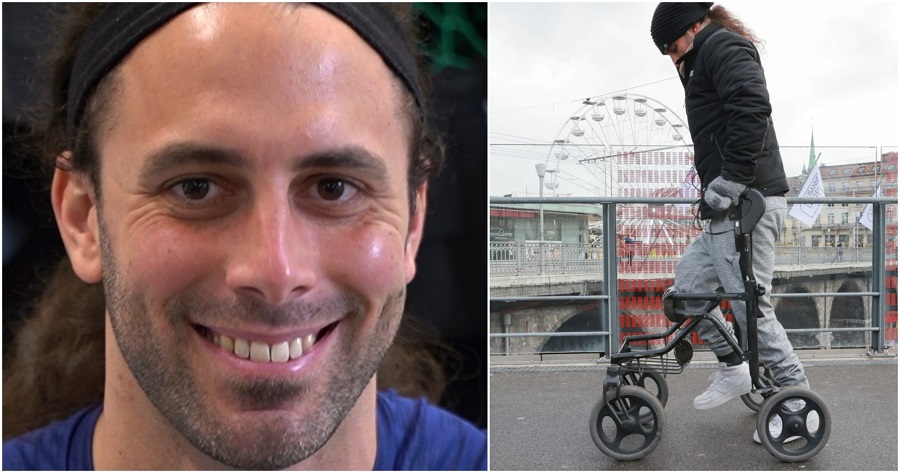Michel Roccati and two other men are learning how to walk again after suffering from severe paralysis for years. All three were injured in motorcycle accidents, but a new spinal injection therapy is helping them do activities they never thought they’d do again.
Moving on Their Own
Roccati, who is from Italy, lost the ability to walk after crashing his motorcycle in 2017, leaving him with a full spinal cord injury.
Roccati, along with two other men between the ages of 29 and 41, participated in the STIMO clinical trial, led by Dr. Jocelyne Bloch from Lausanne University Hospital and Grégoire Courtine of the Swiss Federal Institute of Technology. The results were published this week in the journal Nature Medicine.
According to the report, each patient had a 16-electrode device implanted in the epidural space, between the vertebrae and the spinal cord. The device is controlled by a pacemaker implanted under the skin of the abdomen.
All three men had a complete loss of voluntary movement below their injuries. Two also had a complete loss of sensation in these areas. But once the devices were in place, the researchers used a computer to have the pacemaker send unique electrical pulses to the epidural electrodes, which then activated the patients’ muscles. This system effectively allows the user to retain control of their muscles despite their spinal cord injury.
This type of therapy has been used before, but the STIMO clinical trial accelerated the recovery process dramatically.
When spinal cord stimulators were first developed in the 1980s, they weren’t designed to meet the needs of patients with spinal cord injuries.
According to Grégoire Courtine, a neuroscientist at the Swiss Federal Institute of Technology who co-led the study, earlier implants had a narrow silicone shape that targeted the center of the spinal cord that would disrupt pain signals heading toward the brain. They would trigger slight movements by stimulating the dorsal roots, pairs of thick sensory fibers extending from either side of the spinal cord. The electrode strips were also too short to reach the dorsal roots that control the torso.
That’s why Courtine and his colleagues designed a longer, wider implant. Each one is about the size of a finger. They positioned the electrodes along the surface of the dorsal roots using computer models that predict the ideal position of each implant based on a healthy spine.
The team also created a special software that activates the electrodes based on the person’s position or intended movement. Earlier implants would send repetitive electrical signals, but their software uses patterned signals that help retrain damaged nerve networks in the spinal cord.
All three participants were able to take steps on a treadmill within the first day of receiving treatment. However, they were using body harnesses that supported more than half their weight. This is the first study to show patients with severe paralysis standing up right in a “loaded” position within 24 hours of starting the therapy.
“For the first time, we have not only immediate effect — though training is still important — but also individuals with no sensation, no movement whatsoever, have been able to regain full standing and walking independently of the laboratory,” Courtine added.
After four to six months, all three were able to walk across the ground using only a walker for stability. In earlier studies, it took most patients more than a year to achieve similar results.
“That is remarkable to see within 1 day with a severe injury like this,” said Megan Gill, a research physical therapist at the Mayo Clinic who was not involved in the study. “Intense therapy for a year and a half is a little bit impractical under current health care systems, at least in the U.S.” she says. The new approach would make therapy “meaningful from a health care management perspective.”
Movement on Demand
Getting patients with paralysis moving again can lead to additional health benefits as well, including better cardiovascular function, more bowel and bladder control, increased bone density, and less risk of pressure injuries from prolonged sitting.
The researchers were able to configure different patterns for the electrical signals, so the participants could swim, cycle, and even do leg presses. One patient was even able to climb a staircase.
However, issuing commands to the device remains difficult – at least for now. Users must select their desired movement on a tablet, which then sends a Bluetooth signal to the transmitter around their waist, which must be positioned next to a “pulse generator” implanted in the abdomen, which then activates the implanted electrodes. The entire process can take anywhere from five to 10 minutes.
The results remain impressive, nonetheless.
“I am free,” said Roccati during recovery. “I can walk wherever I want to.”
“It’s a very emotional moment, because [patients] realize they can step,” said Dr. Jocelyne Bloch, who co-led the study along with Courtine.
However, some patients may have trouble acclimating to the process.
“The more they train, the more they achieve, so they need the motivation to be able to stand a long time,” Bloch added.
Experts say more research is needed to see how the device can best be used to facilitate a full recovery.
“I think [this research] should be a call for all of us to understand that there is hope for the treatment of these patients,” said Dr. Nicholas Theodore, director of the Johns Hopkins Neurosurgical Spine Center, who was not involved in the research. “I think the hope right now is going to be through an engineering solution and less so than cellular reparative strategy.”
Both Courtine and Bloch plan to make the device more user-friendly in the future. The FDA has given the treatment the “breakthrough devices” designation, which will help speed up the approval process.
This designation would also ensure coverage through the Medicare Coverage of Innovative Technology program if larger clinical trials are successful.



